S electing and booking your shooting location can be a daunting challenge. Is a permit required? How do you get the owner’s permission? What does your location scout need from you? How do you handle insurance? Do you need a film location release? In this article, we’ll unpack the location securing process step-by-step and provide you with a free film location release form for use on your next production.
What is a Location Release Form?
A legal document that protects your film
What is a location release form, and why is it so important? Before you scout the perfect location, you need to understand this one essential piece of paperwork.
A location release form is a type of consent form and legal agreement between a filmmaker and a property owner that grants permission to film at a specific site. It protects both parties by setting expectations about access, responsibilities, and usage rights.
Without a signed location agreement, you risk legal issues, delays, or even lawsuits if a property owner rescinds permission. A properly executed film location release form—or set of film location release forms if you have multiple sites—ensures your production stays on schedule and in compliance.
How to Find and Secure Film Locations
1. How to pick your shooting region?
Research incentives and permitting costs
Before you start scouting individual locations, consider which cities would make the best hosts for your film, as some regions offer tax or rebate incentives.
In Southern California, Riverside County offers fee-free permits and even allows free filming on county property. In Santa Monica, you can shoot on private property without a permit as long as you have the owner’s permission.
To learn about the costs and requirements of shooting on public property, contact the film commission in that city.
Consider shooting logistics for the location
Your shooting region should be accessible to your cast and crew.
Some shooting locations may be beautiful, but if the transportation or lodging costs are too high, you may need to pass on it.
A good location scout can help guide you in this regard.
Another thing to keep in mind:
As you gather all of your contacts and location information, you can record and organize everything in your StudioBinder contacts page. Click the image link below to explore StudioBinder's film crew management software.
You have built a career in film and entertainment, so it is great to have the ability to keep every piece of new information stored and organized while you produce each of your projects.
Consider a filming location solution
If you’re navigating the location search on your own, a filming location app like Wrapal can be a helpful tool. Wrapal connects filmmakers and property owners directly, offering a streamlined way to find or list filming locations, similar to how Airbnb works for short-term rentals.
Through the app, users can negotiate pricing, set ground rules, and leave reviews, making the often frustrating process of securing a shooting location far more turn-key. Positive reviews can also boost a location manager’s reputation for future projects.
If you plan to scout your locations, check out our tips below. If you’d rather hire a professional to save time and stress, keep reading.
Here are some location scouting tips to consider if you want to scout your locations. If you want to hire a professional, keep reading.
Should You Hire a Location Scout?
2. Consider hiring a location scout
You can either hire a location scout or go out on your own. Although it may cost a bit extra to hire a location scout, the amount of time it’ll save you could pay for itself, especially for filmmakers, photographers, and small production companies working on tight schedules.
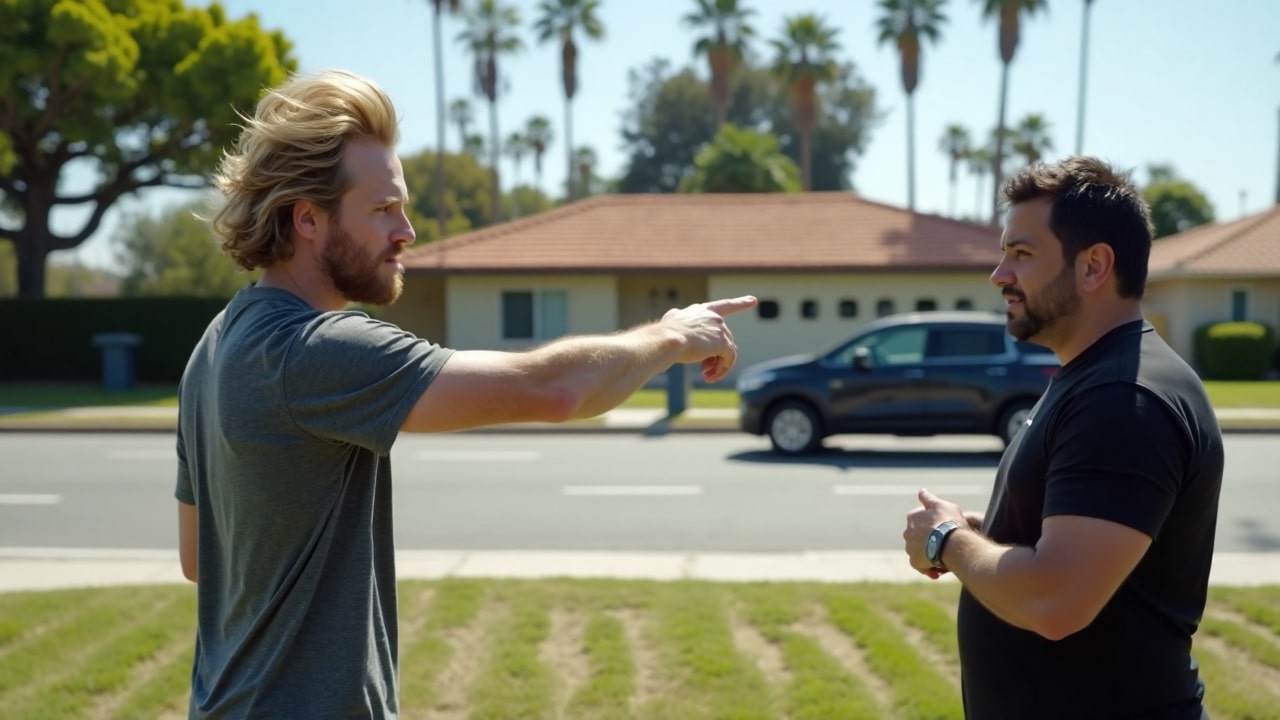
Why should you hire a location scout for your film locations?
- Searching for locations
- Cold calling and coordinating with the owner
- Taking and organizing location photos
- Considering potential issues
- Summarizing location notes
- Identifying and negotiating costs
Related Posts
Location Scouting Checklist for Filmmakers
3. Location Scouting Checklist
Every location comes along with its logistical considerations. Here are some of the most common questions to ask yourself (part of our location scouting checklist):
Does this location fit the scene?
Can you control the location?
Is there a lot of noise from airplanes or a nearby highway?
Are there lots of visible trademarks and logos that might become a problem for the production, such as in a grocery store or bar?
Does it offer the resources you need (e.g., running water, restrooms, access to power, crew parking, etc.)?
PRO TIP: LOCATION SCOUTING
If you’re short on time, you or your location scout can bring copies of your location agreement release form with you. When you find a location that you like, have the owner sign the location agreement release right on the spot.
How to Approach Property Owners
4. Negotiate a location agreement
If you’re going to be shooting in a private location, now it’s the time to call up the property owner.
Pitching a property owner (script):
“Hi, is the manager or owner in please?”
(Allow them to respond. If they’re not in, leave a message.)
My name is [your FULL NAME]. I’m an independent film producer.
We’re doing a [SHORT FILM] that we’re going to be submitting to film festivals and online. We’re going to be shooting in June. We need the use of a convenience store for a couple of scenes, and we’d like to film in your store.”
(Allow them to respond.)
“We wouldn’t need it for too long. It’ll probably take [1-2 nights] depending on how it goes, preferably after you guys close, like at [10:30 AT NIGHT] so we wouldn’t interrupt your business.
(Then ask if they have any questions. If you’re leaving a message simply conclude with the following…)
So let me give you my number just so you have it. Hopefully you can pass it along to the owner. The number is [YOUR NUMBER]. Thanks!”
Negotiate smart
When pitching a property owner, always be honest about the size and nature of your film project. Misrepresenting your production size can backfire quickly, leading to revoked permissions or even lawsuits.
If you’re working with a tight budget, offer creative compensation such as free meals, on-screen credit, or promotional posts for businesses. Any agreements should be documented in your film location contract or film location agreement to protect both sides.
Legal tip
Always ensure the person signing the location release has true authority to grant permission. If you’re filming at a business, make sure it’s the owner, not just a manager or tenant, who signs. Confirming ownership upfront can save major headaches later.
Ask if they have any questions
Most property owners have never seen a film production before, so they'll have a bunch of questions.
Describe your film production accurately. Don’t tell them you’re a small indie crew when you plan to show up with forty extras!
Pro TIp
Be empathetic. A film crew can be very disruptive when a production enters a business or home. People who aren’t in entertainment don’t realize just how long or chaotic production can be. I’ve seen many situations where people invited us to shoot, expecting the whole thing would only take a few minutes, unprepared for the twelve-hour workday.
Set a time to deliver the location release form
Once the property owner agrees, you’ll want to get it in writing just in case they change their mind. A location release form is a requirement before you set foot on their property with any equipment, and it protects both parties.
Execute the agreement as soon as possible before the shoot, at least a week or two in advance.
If you haven't already done a tech scout, you'll want to before you secure the location. You don't want to sign papers and move forward until you know the location works for your team and your production.
How to Tech Scout Like A Pro • Subscribe on YouTube
When everything is confirmed, you can email the location release form to the property owner for signature.
However, remember that they are generously offering their space for your film project—taking the time to meet in person or showing a little extra appreciation can go a long way toward building trust and ensuring a smooth experience on set.
PRO TIP: LOCATION RELEASE FORM
For a quicker signing experience, fill in as much information as possible on the location release form prior to sending (or seeing) the location owner. Once the agreements are fully executed, make sure the location owners receive a copy.
Related Posts
What If You Don’t Use a Location Release Form?
The legal and production risks
Skipping a location release form—or failing to execute a proper film location contract—might seem tempting when you’re on a tight schedule, but the risks are enormous:
Production shutdowns: Property owners can legally demand that you leave mid-shoot.
Lawsuits: Filming without permission can expose you to trespassing or damages claims.
Insurance issues: If an accident happens, your insurance provider may deny coverage without a documented location agreement.
Distribution problems: Film festivals, streamers, and distributors often require film location release forms to verify legal clearances and protect against legal disputes.
Bottom line: Using a signed film location release form protects your production, your budget, and your distribution plan.
Location Release Form
5. Free location release form template
Here are the major sections of a typical location release, which you’ll also find in our Location Release Form Template.
FREE DOWNLOAD
Film location release form template
Planning to secure a shooting location for a film project? Download this location release template for peace of mind.
FREE Download: Film Location Release Form Template
Planning to secure a shooting location for a film project? Download this location release template for peace of mind.
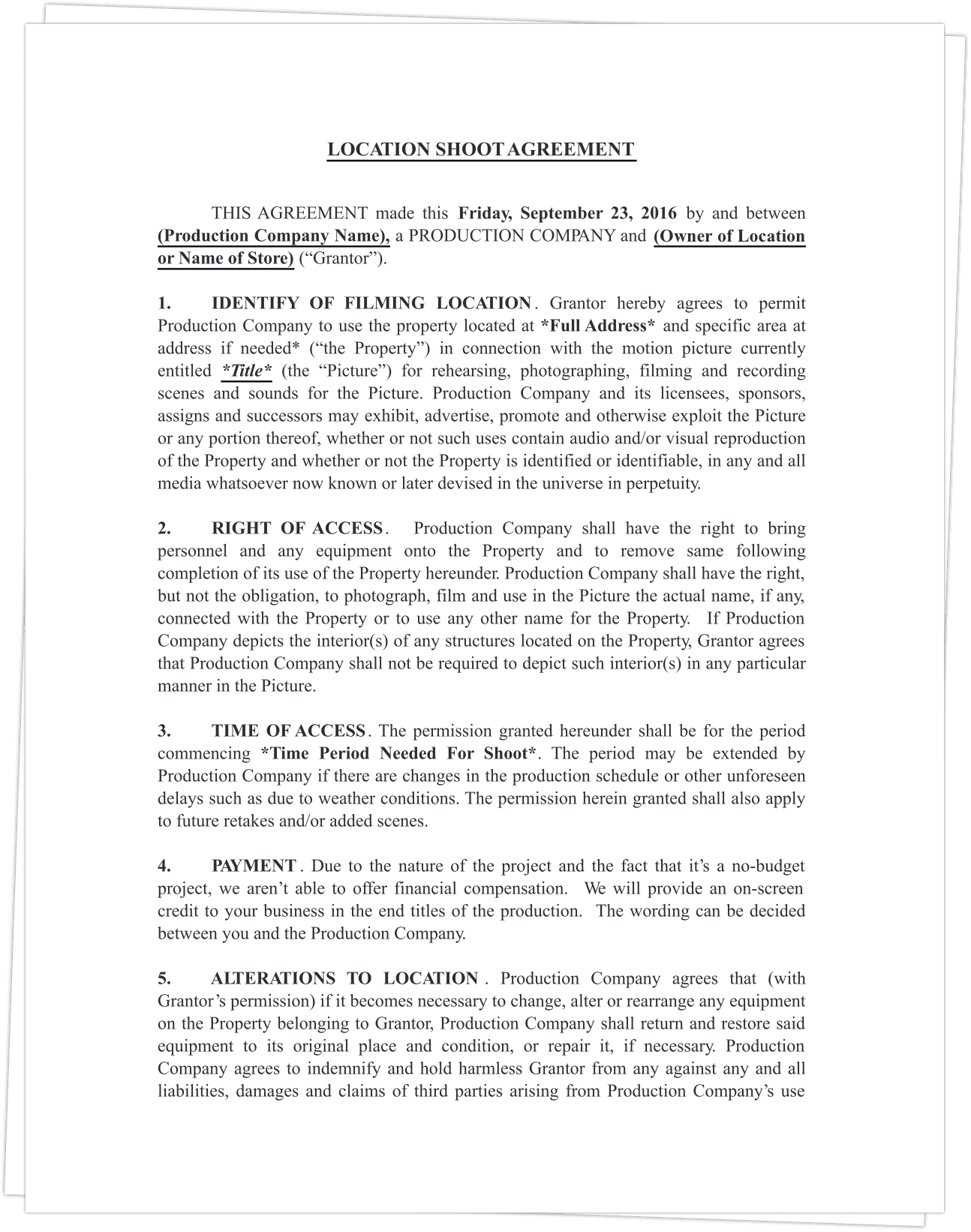
Download your FREE Location Release Template.
Just enter your email address and we'll instantly send it to you!
Identify:
This is where both the location and the filming project are identified. Make sure to include the location name (if available) and the full address — nothing vague here. If required, add a note about where within the property you have permission to film, a necessity if you’re only permitted to access certain areas.
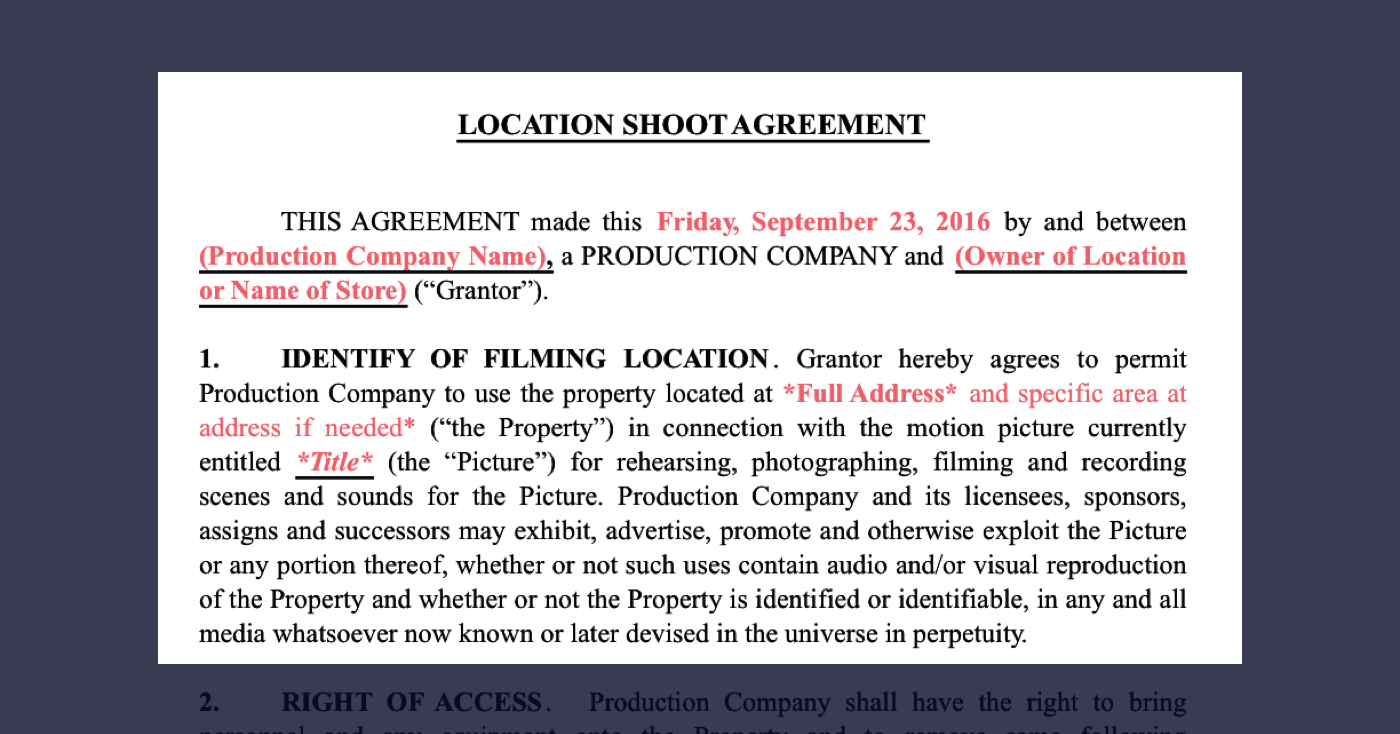
Location shoot agreement
RIGHT OF ACCESS:
This defines what the production company is allowed to do at the location.
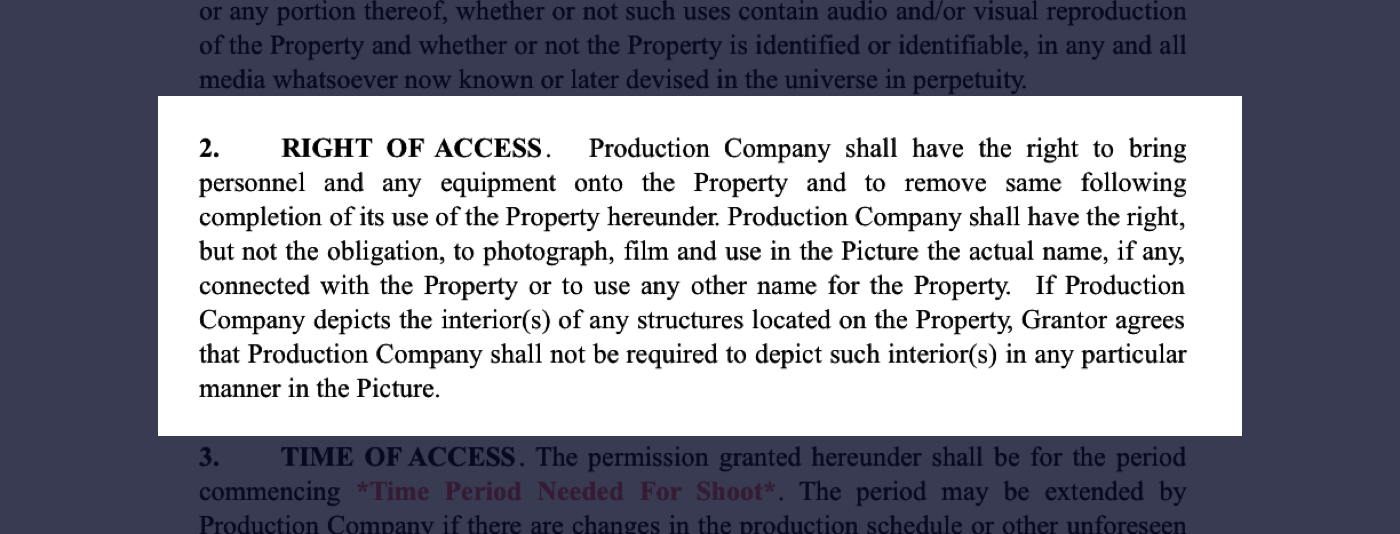
Location shoot agreement • Right of access
TIME OF ACCESS:
This defines when and for how long the location owner will permit the production to access their property. Push for as much time as you can here.
It’s common for location owners to get upset if you go over schedule, and either demand more money or kick you out.

Location shoot agreement • Time of access
COMPENSATION:
Define exactly what and when the production will compensate the location owner for use of the location.

Location shoot agreement • payment
ALTERATIONS TO LOCATION:
Over the course of production, you might need to make changes to the location (e.g., painting the walls, hanging pictures, etc.). Regardless of whether or not the location owner will notice your alterations, you need to get permission to make these changes and change things back at the production’s expense.
There’s typically language in this section stating that the location owner has the authority to permit modifications to the property, or frees you from responsibility in the event of ill-described ownership.
For example, if your friends are letting you shoot in their apartment (that they are renting), they technically do not have the legal authority to permit you to modify the apartment. Therefore, if you modify it, and your friend gets in trouble, this clause keeps you out of trouble.
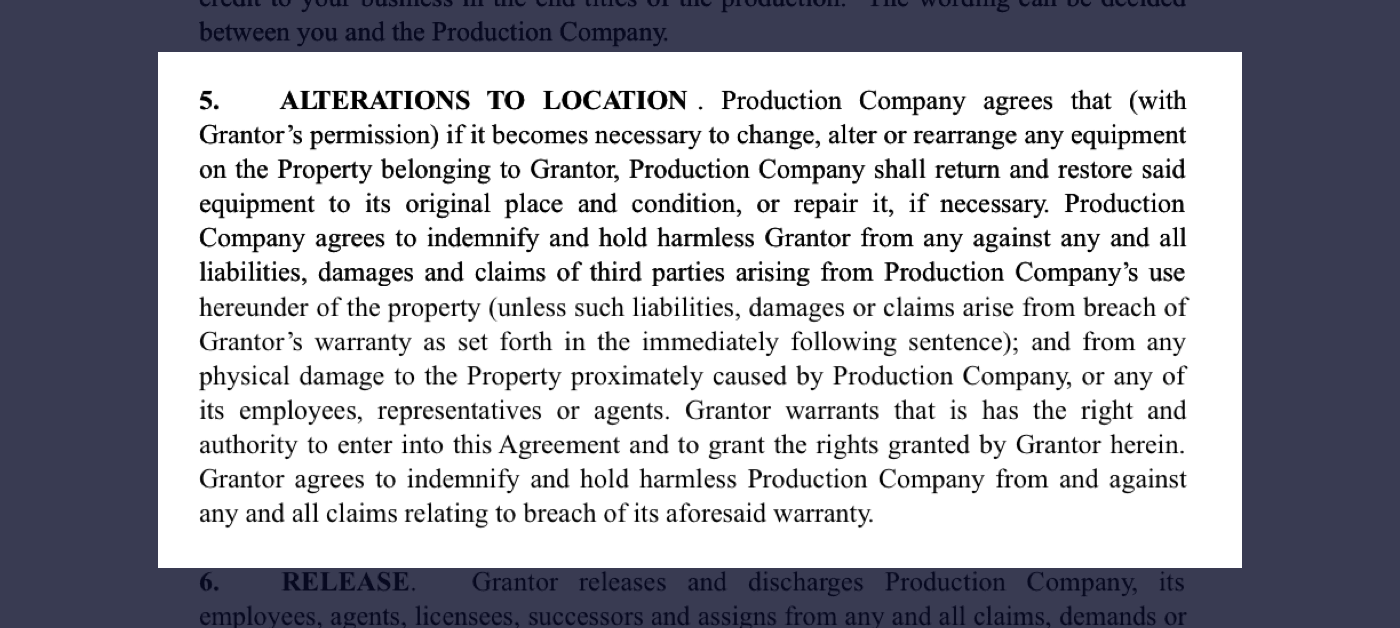
Location shoot agreement • Alterations to location
RELEASE:
This is why this document is called a “Location Release Form” (some people also call it a “Film Location Agreement Form”). This section gives production permission to depict the location on-screen!

Location shoot agreement • Release
LEGAL DETAILS:
Usually, the last section of a Location Release Form is where the agreement is localized to the laws of a particular state (typically, the state that you’re shooting in; not necessarily the production company’s home base).
There’s usually a clause here with language about “successors, assigns, heirs, executors, etc.,” which is important for maintaining your chain-of-title. This allows you to transfer the permission the contract grants to someone else.

Location shoot agreement • Miscellaneous
SIGNATURES:
As with any contract or agreement, both parties need to sign the agreement before it’s legally binding. Typically, the location scout doesn’t have the legal authority to bind the company to agreements, even location agreements. The producer should therefore sign all necessary documents.
Once you’ve filled out the film location release form template and your location owner signs it, you can secure your location permit from the city or county!
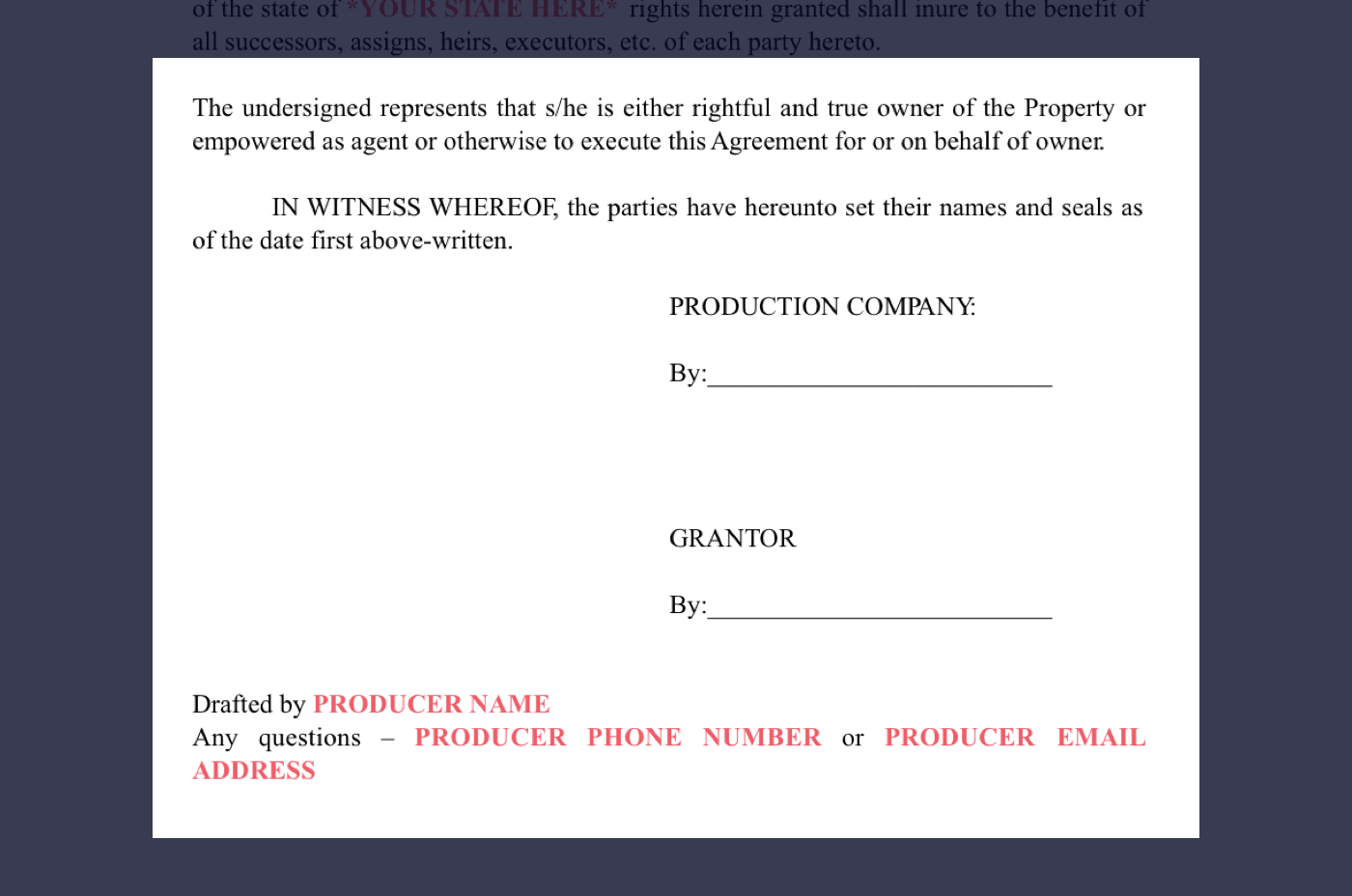
Location shoot agreement • Signatures
Related Posts
Location Scouting Tips
6. How to protect your shooting location
When shooting, remember this is someone’s home or business...
Treat it with care.
Protect fragile things like hardwood floors or glass furniture by laying cardboard or furniture pads.
Don’t walk on the grass unless you’ve been permitted to do so.
When finished, return everything to its original condition.
Take out the trash at the end of the day.
If you are a good steward, the location owner is more likely to treat the next filmmaker with kindness and generosity. We all benefit from that.
For a refresher on etiquette, check out Tips for Proper Film Set Etiquette.
Real-world example
During an indie short film production in Los Angeles, one team failed to protect hardwood floors inside a historic home. The resulting floor damage cost the filmmakers thousands in repairs—and the owner blacklisted them from future projects.
By contrast, another team filming at a nearby location used furniture pads, placed runners over high-traffic areas, and cleaned thoroughly after wrap. That property owner not only gave them a glowing review but also referred them to three additional shooting locations, saving time and money on future films.
Protect your reputation and your bottom line: treat every shooting location with the respect it deserves.
StudioBinder disclaimer:
We love to provide resources and templates to filmmakers. Just please remember, this article should be construed as informational, not legal advice. StudioBinder does not provide or offer legal advice to its readers.
StudioBinder, its editors, and authors will not be held responsible for any legal issues the reader might encounter based on the subjects found in this post.
As always, we recommend you consult a legal expert for advice on video release forms, location agreements, and filming contracts. This disclaimer assigns you, our readers, all responsibility for your own decisions.
UP NEXT
Schedule the “Hidden” shoot locations
Check out our post on Finding and Scheduling the "Hidden" Shoot Location in a Script, where we show you how to find locations in your script that may not be initially obvious without a bit of pre-production experience.
Up Next: “Hidden” Shoot Locations →
Manage talent & film crew contacts, all in one place.
Create and share mobile-friendly contact lists, call sheets, calendars and more. Complete video project management for producers & coordinators.

